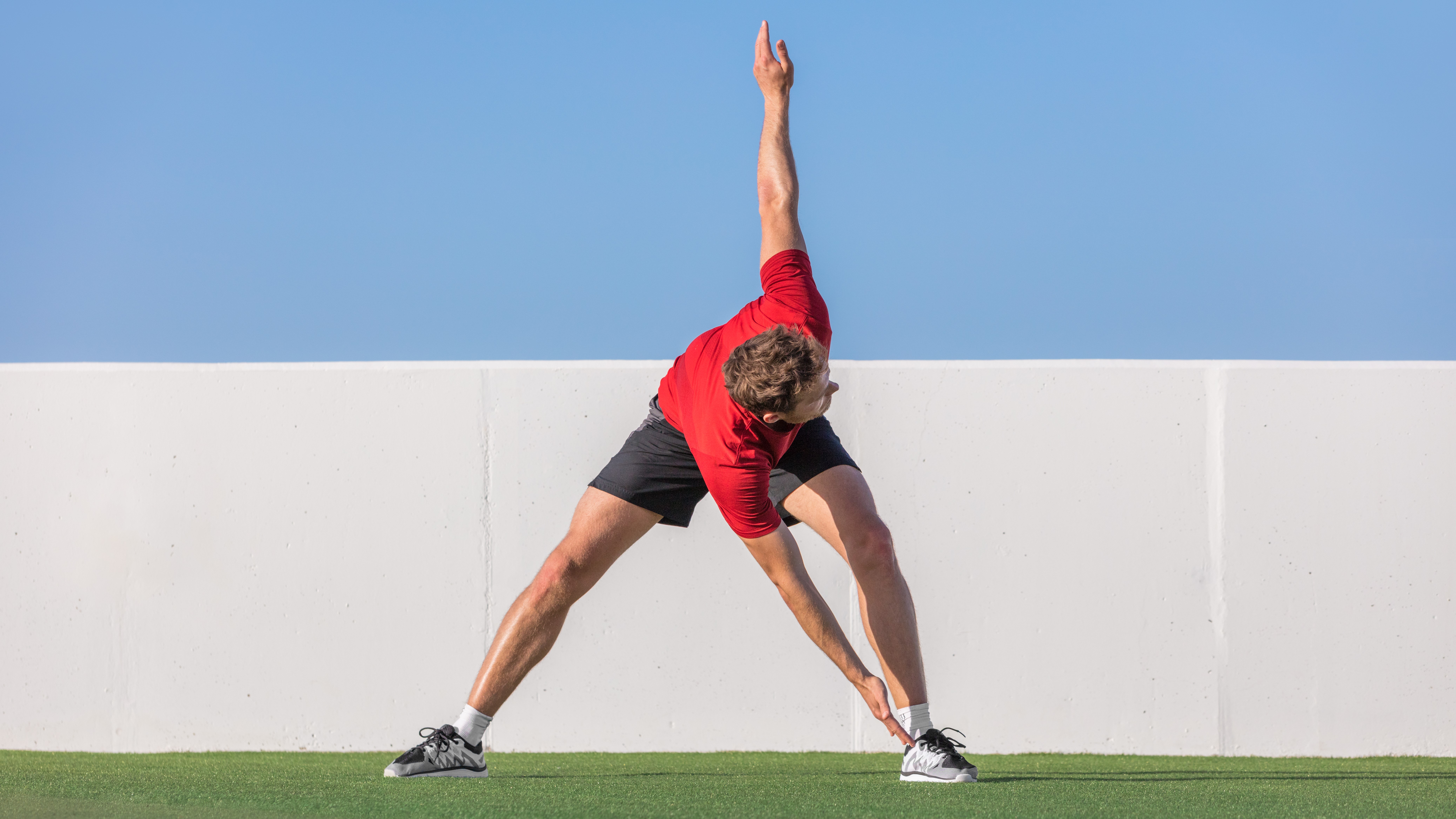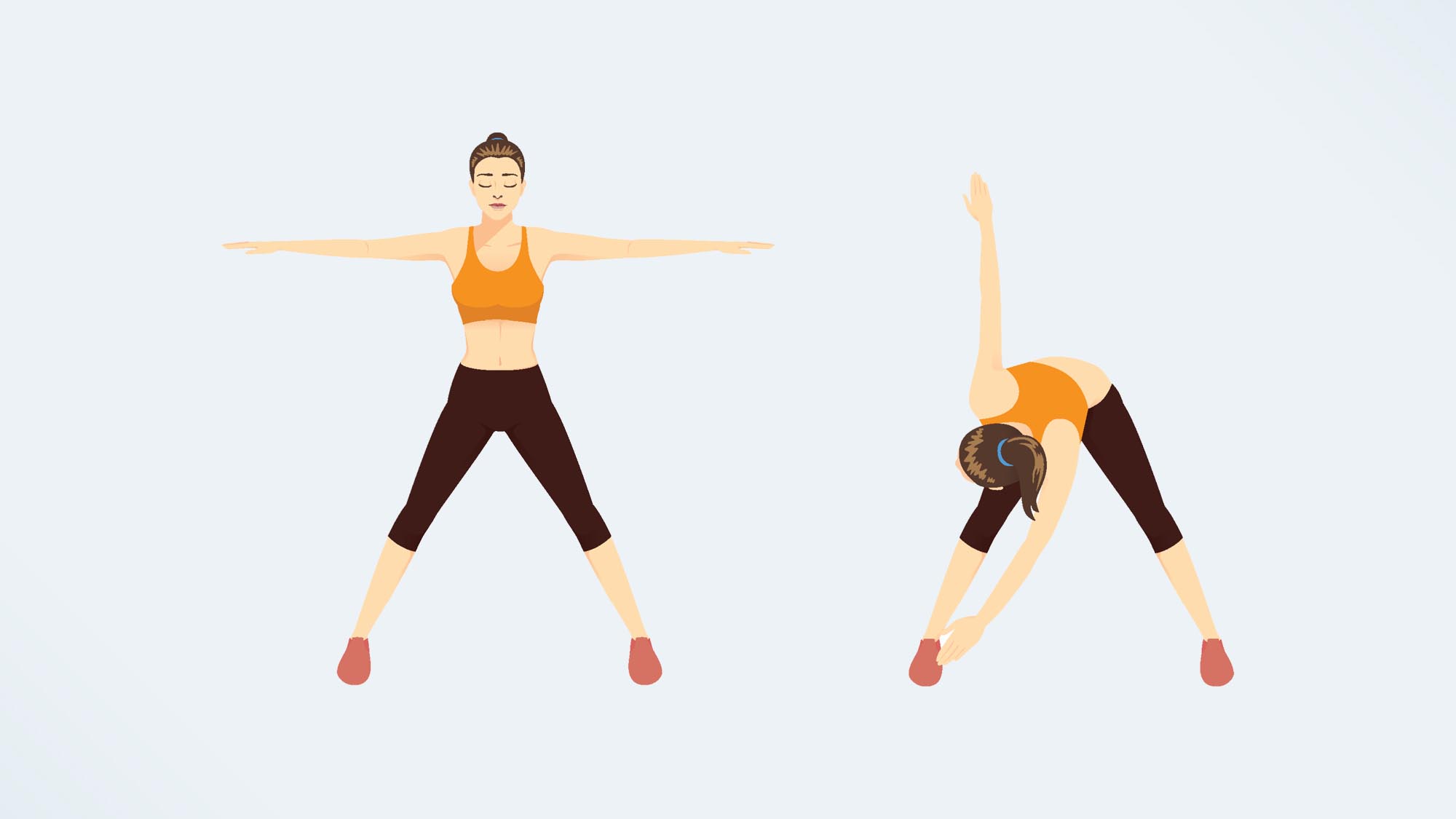I did 50 standing toe touches every day for a week — here’s what happened to my abs

When it comes to working your abdominal muscles, not all exercises are created equal. Traditionally, working your oblique muscles — the muscles that run along the side of your trunk, and help stabilize your body as you bend and twist your torso, probably involves performing Russian twists, or side planks. That said, if you struggle to get down onto an exercise mat, and you’re looking for a standing ab exercise that’ll do a similar job, I’ve found exactly what you’re looking for.
The standing crossover toe touch is a standing ab exercise that targets the oblique muscles. That said, you’re getting a lot of bang for your buck with this compound bodyweight ab exercise, as it also targets the muscles in your lower back. It’s a good one to include in your warm-up before lifting weights, but is also suitable for anyone looking to work on their core strength, without having to lie down on an exercise mat. But how do you do it? And what would happen if you did 50 standing toe touches a day for a week? To find out more, I gave it a go. Read on to find out what happened.
As a reminder, what works for me might not be right for you and your body. If you’re new to exercise, or you’re returning to exercise following an injury or a pregnancy, it’s always good to check your form with a personal trainer before adding reps.
How to do a standing crossover toe touch
Let’s start by taking a look at how you do a standing crossover toe touch with perfect form:

- Start by standing with your feet wider than shoulder-width apart, and your arms outstretched to either side of your body. Turn your toes out slightly, and have a slight bend in your knees.
- Engage your core, thinking about sucking your belly button in towards your spine.
- Hinge at your hips, push your glutes back, and twist your torso to lower one hand to touch your opposite foot. Keep your back as straight as possible during the movement — this is not a forward bend.
- Pause here, then return to your starting position, again, keeping your back as straight as possible during the movement.
- Repeat on the opposite side.
- Keep alternating sides until you have completed the desired amount of reps.
As with all ab exercises, it’s important to move slowly and with control throughout this movement. Your back should stay straight and your chest open as you rotate from side to side — rounding the back means the obliques don’t have to work as hard, reducing the effectiveness of the exercise.
Depending on your mobility, you might not actually be able to touch your toe, but this doesn’t matter. Reach down as far as you can, or bend your knees to help you reach your toes, just remember to keep squeezing your obliques as you rotate your torso from side to side.
I did standing crossover toe touch every day for a week — here’s what happened
Here’s what happened when I did 50 standing crossover toe touches every day for a week.
Get instant access to breaking news, the hottest reviews, great deals and helpful tips.
I felt this in my hamstrings and lower back
As mentioned in the intro — this is definitely a compound ab exercise, as it targets more than just your abdominal muscles. I felt my shoulders, hamstrings, lower back, and glutes working during this exercise, especially when I added the exercise to my routine on days when I’d spent hours sitting behind my desk. As a runner, I typically have pretty tight hip flexors, and I found this ab exercise helped me stretch my hips, hamstrings, and glutes.
On the first couple of days, I opted to do all 50 reps in a row, taking a few seconds break halfway through. I focused on moving slowly, and with control as I worked on my form, and treated it like a side bend in yoga, really focusing on extending my opposite arm to the ceiling as I twisted. I focused on my oblique muscles, helping establish the mind-body connection.

It’s harder than it looks
On day one, I thought this week would be a walk in the park, but a few days into the challenge, I could feel my oblique muscles popping as I really focused on twisting my trunk. Again, it’s important to think about sucking your belly button into your spine as you twist during this move — it’s important to not let the back arch. If you do find your back arching during this move, pause and reset, or bend your knees to make it easier to touch your foot.
As the week went on, I found myself getting pretty bored in this move, but unlike doing Russian twists every day for a week, this one didn’t put any strain on my lower back. Far from being an easy option, standing ab exercises work on your balance, coordination, and stability more than you would be lying down. You’re also more likely to recruit other muscle groups and are great if you’re short on space.
Finally, standing ab exercises are often more accessible to those recovering from an injury, pregnant women who shouldn’t spend too long lying on their backs (although always check with your doctor or midwife first), or those with arthritis or joint injuries that make kneeling, or hands-and-knee core exercises like planks difficult.
I didn’t notice any visible change in my abs
Like most of these week-long challenges, I didn’t notice any visible differences in my abdominals. Visible abs aren’t the result of endless crunches, plank, or standing twists, but a reflection of your overall body fat percentage — here’s how to calculate your body fat percentage and why it matters, plus 5 reasons why you might not be able to see your abs, despite working out.
That said, I really enjoyed this standing ab exercise, and I’ll definitely be incorporating it into my warm-ups before I head out the door for a run in the future. I found it helped me to get a nice stretch in my lower back, and get my obliques firing, which in turn helped run with better form. If you’re looking to work your oblique muscles without putting strain on your lower back, this is definitely one to add to your routine.
More from Tom's Guide
- Forget sit-ups — this 3-move ab workout chisels concrete core muscles in 15 minutes
- This abs workout for beginners sculpts a strong core in 4 moves and 20 minutes
- Forget push-ups, this kettlebell shoulder workout chisels your pecs and shoulders in 3 moves

Jane McGuire is Tom's Guide's Fitness editor, which means she looks after everything fitness related - from running gear to yoga mats. An avid runner, Jane has tested and reviewed fitness products for the past five years, so knows what to look for when finding a good running watch or a pair of shorts with pockets big enough for your smartphone. When she's not pounding the pavements, you'll find Jane striding round the Surrey Hills, taking far too many photos of her puppy.
